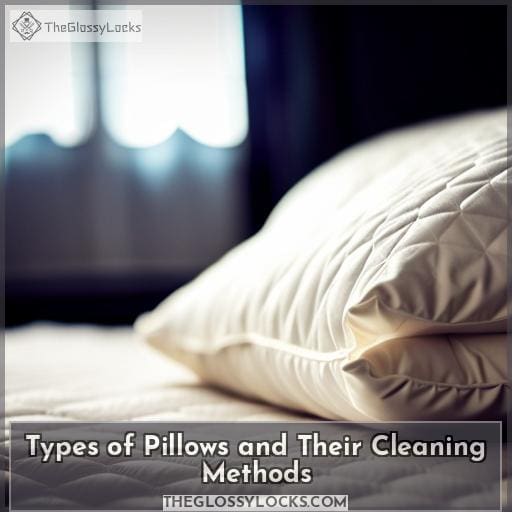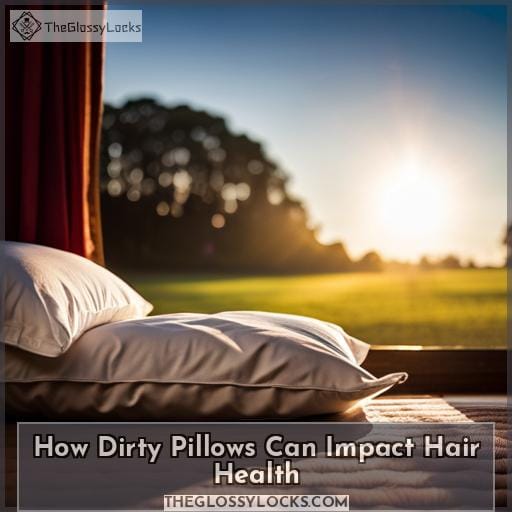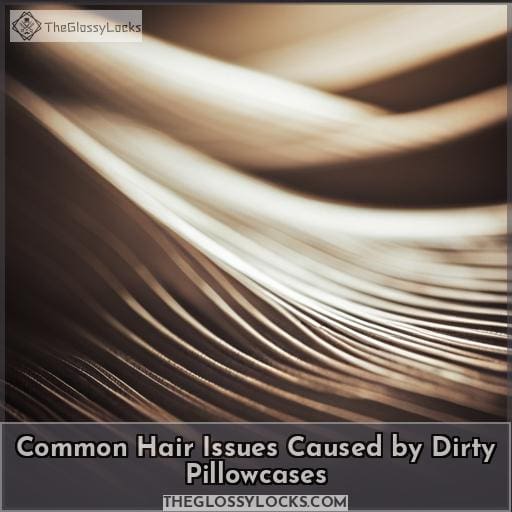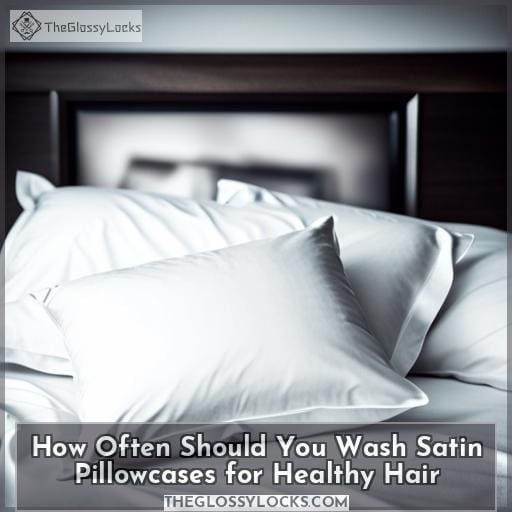This site is supported by our readers. We may earn a commission, at no cost to you, if you purchase through links.
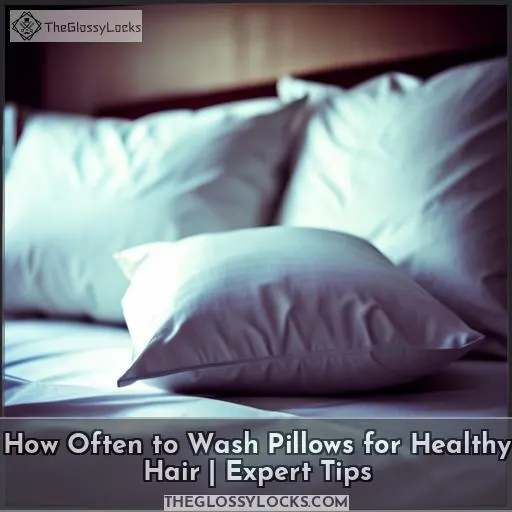 Do you ever stop to think about the role your pillow plays in achieving that clean hair feeling? It’s true, pillows can have a significant impact on the health and cleanliness of your precious locks. As it turns out, how often to wash pillows for healthy hair is an important factor in maintaining good hygiene and preventing scalp issues.
Do you ever stop to think about the role your pillow plays in achieving that clean hair feeling? It’s true, pillows can have a significant impact on the health and cleanliness of your precious locks. As it turns out, how often to wash pillows for healthy hair is an important factor in maintaining good hygiene and preventing scalp issues.
But what kind of cleaning methods should be used depending on the type of pillow? And how dirty pillows can affect hair health? From synthetic fiber down alternative materials to memory foam or gel styles – get ready as we dive into all there is to know when it comes to washing bedding accessories for healthier-looking tresses!
Table Of Contents
- Key Takeaways
- How Often to Wash Pillows for Healthy Hair
- Why Clean Your Pillows Regularly
- Types of Pillows and Their Cleaning Methods
- How Dirty Pillows Can Impact Hair Health
- Common Hair Issues Caused by Dirty Pillowcases
- How Often Should You Wash Satin Pillowcases for Healthy Hair
- Washing Pillowcases to Reduce Dandruff on the Scalp
- Tips for Maintaining Healthy Hair With Clean Pillowcases
- Conclusion
Key Takeaways
- Regular pillow washing reduces dandruff and dryness.
- Dirty pillows can lead to scalp issues and hair damage.
- Satin pillowcases promote healthy locks.
- Change/wash pillowcases once a week for optimal sleep quality.
How Often to Wash Pillows for Healthy Hair
Wash your bed pillows regularly to keep your hair looking and feeling its best! Pillowcase frequency is key when it comes to proper hair care. Washing pillowcases at least once a week can help reduce dandruff, dryness, and scalp irritation.
Consider switching out cotton for satin pillowcases, which don’t absorb moisture as much as other fabrics do. This helps keep the natural oils in your hair intact while you sleep. Regular washing not only guards against dirt build-up from sweat or pollutants, but it also helps maintain healthy locks by eliminating dust mites that may cause scalp inflammation.
Taking time for proper pillow care will benefit not just your hairstyle, but also your overall well-being. It improves air quality by reducing allergens in the bedroom environment. To maximize hygiene benefits, wash two pillows at a time on a gentle cycle with warm water.
Alternatively, spot clean memory foam pillows every two weeks using mild dish soap.
Why Clean Your Pillows Regularly
By regularly cleaning your pillows, you can help maintain their comfort and reduce the risk of developing asthma or allergy symptoms. Pillow cleaning also has other benefits for hair health. Removing sweat, drool, bacteria, dust mites, and more from pillowcases makes them less likely to become breeding grounds for dandruff-causing microbes that could be damaging your hair follicles.
Cleaning also extends the lifespan of a pillow so it won’t need replacing as often due to yellowing or mustiness – meaning you’ll have one less thing to worry about in terms of hygiene! If washing instructions recommend handwashing only, then make sure not to wring out too much water after soaking in soapy water; air drying is key here!
Spot clean memory foam pillows every 2-3 months with mild dish soap before air drying completely; refresh by sprinkling baking soda over it, then vacuuming away any excess powder afterwards. Finally, remember when caring for a mattress, always check the manufacturer’s care instructions as this may differ slightly depending on the material type, such as latex or down feather filling.
Types of Pillows and Their Cleaning Methods
Keeping your pillows clean is essential for a healthy lifestyle. There are several different types of pillows that require unique cleaning methods.
Synthetic fiber and down alternative pillows can be machine-washed using Tide Free & Gentle Liquid Laundry Detergent.
Feather and down pillows should either be washed on a no-heat or air-fluff setting.
Memory foam, latex, and gel pillows cannot be machine-washed. Instead, they need to be spot cleaned every 2–3 months with mild dish soap.
Synthetic Fiber and Down Alternative Pillows
You can keep synthetic fiber and down alternative pillows feeling fresh with regular washing, so you can rest easy without worry.
To maintain pillowcases for healthy hair care, wash them at least once a week or more if needed.
Synthetic and down alternative pillows should be machine-washed using a tablespoon of detergent on gentle cycle with warm water and an extra rinse.
Use dryer balls to fluff the pillow in low heat setting when drying completely – air-drying is also an option for these materials!
Regular cleaning helps extend their lifespan while promoting scalp health by eliminating dust mites, sweat, body oils, and bacteria from your bedding environment.
Proper maintenance of all your bedding items will ensure you get quality sleep every night!
Tide Free & Gentle Liquid Laundry Detergent
For optimal hygiene and comfort, try Tide Free & Gentle Liquid Laundry Detergent for washing your pillows. This detergent provides essential benefits such as deep cleansing of dirt particles, gentle fabric care to maintain the softness and quality of the pillow filling, as well as a pleasant scent that will leave your pillows smelling fresh.
It is easy to use in the washing machine with its low sudsing formula, making it suitable for both standard top-loaders or high-efficiency machines.
Cleaning frequency depends on usage and factors like eating in bed or having pets on the bed. This product can help you keep up with regular cleaning cycles while protecting against dust mites, which can lead to skin irritation or worsen allergies if not controlled properly.
With Tide Free & Gentle Liquid Laundry Detergent, you ensure optimal pillow hygiene without compromising comfort!
- Deep cleanses dirt particles
- Provides gentle fabric care
- Low sudsing formula suitable for all types of washers
S&T Inc. Reusable Laundry Dryer Balls, 6-Pack
Add S&T Inc. Reusable Laundry Dryer Balls to your cleaning routine for fluffing and extending the life of pillows – like gentle giants in the dryer. They help maintain pillow comfort, preventing asthma and allergy symptoms due to dust mites, sweat, bacteria, or body oils accumulated on bedding items over time.
Use them with synthetic fiber or down alternative pillows on a low-heat setting. Feather & down can be air-fl■ instead of machine washed. Memory foam should only be spot cleaned every 2-3 months with mild soap and completely air dried for best results.
Proper pillow care not only improves sleep but overall hygiene too. Remember to replace your pillows every two years or so if regular washing doesn’t keep up their quality.
Feather and Down Pillows
When it comes to feather and down pillows, regular cleaning helps keep them comfortable and free of bacteria. Pillowcases should be washed once a week for healthy hair hygiene, while the feathers must be machine-washed with no-heat or air-fluff settings every 4–6 months.
For an extra clean feeling, launder pillowcases in hot water using mild detergent and double rinse cycles if you have sensitive skin or allergies/asthma that require more frequent sheet washing.
Memory Foam, Latex, and Gel Pillows
Memory foam, latex, and gel pillows can’t be tossed in the washing machine – they need special care to keep them looking their fluffy best! Spot clean with mild dish soap every 2-3 months.
To deep clean, soak the pillows in soapy water, rinse thoroughly, and squeeze out excess moisture before air drying in the sun.
Refresh memory foam pillows by sprinkling baking soda, then vacuuming for added pillowcase maintenance and hair health benefits.
Memory foam has hypoallergenic properties, so it needs less frequent cleaning compared to other fill types.
Replace your pillow every two years for optimal comfort and hygiene, as well as following the manufacturer’s instructions on how often you should wash your pillows according to the type of filling used.
How Dirty Pillows Can Impact Hair Health
Without proper care, dirty pillows can leave you with lackluster locks and an itchy scalp. Pillowcase hygiene is a key component of any haircare routine. Not only does dirt on the pillow accumulate from everyday use, but also natural oils and sweat that are transferred to the pillow during sleep cause friction between strands of hair, leading to breakage over time.
In addition, unclean pillows can lead to scalp issues like dandruff, which further damage your hair health for long-term effects.
Here are several ways in which you should maintain good hygiene practices when it comes to your bedding:
- Replace your pillowcases every two weeks or more frequently if needed.
- Wash all bedding at least once a week using hot water settings.
- Machine washable items such as feather/down pillows may be washed less often than other materials.
- Consider dry cleaning down-filled items instead of machine washing them.
- Don’t forget about mattress maintenance by vacuuming monthly or spot treating stains regularly.
Keeping up with regular maintenance not only ensures cleanliness but will save money in the end due to avoiding purchases of new products prematurely caused by neglecting these simple habits now! With some effort put into keeping everything fresh, one can ensure beautiful tresses while resting peacefully through even better quality slumber each night!
Common Hair Issues Caused by Dirty Pillowcases
It’s easy to forget that pillowcases and sheets should be washed regularly. But dirty pillows can cause a range of hair problems, from breakouts to frizziness and split ends.
Washing frequency depends on factors like usage, pets, and sweating, so it pays to know the basics of proper pillowcare. For optimal hygiene benefits, experts recommend washing bedding at least once per week, or more if you’re prone to allergies or have pets.
Pillowcases specifically should be replaced every 1-2 weeks as they hold onto dirt and oils from your skin while sleeping. Silk covers are great for reducing breakouts since they don’t absorb product residue like cotton does.
Also, consider using hypoallergenic materials such as down alternative pillows, which require less frequent deep cleaning than feather or memory foam varieties.
Cleaning eliminates harmful bacteria that could damage hair health over time, so make sure regular maintenance is part of your routine regime today!
How Often Should You Wash Satin Pillowcases for Healthy Hair
Caring for your hair doesn’t have to be complicated—keep it luscious and strong by regularly swapping out your satin pillowcases! Satin is known for its smoothness, which promotes healthy locks.
- Wash every one to two weeks with cold water and mild detergent.
- Use an extra rinse cycle if your skin is sensitive or prone to irritation.
- Air dry completely before using again—never use heat as this can damage the material’s soft texture.
A clean pillowcase helps promote scalp hygiene, preventing product build-up in the follicles that can cause breakage or split ends over time.
To ensure optimal health of both the scalp and hair strands, change out your satin pillowslip after each wash cycle so as not to avoid excess wear-and-tear on either end of the washing frequency spectrum—one week being too few washes while two weeks being too many washes depending upon individual needs such as allergies/asthma or sweat levels during sleeping hours, etcetera.
Keeping these simple steps in mind will help maintain beautiful tresses all year round!
Washing Pillowcases to Reduce Dandruff on the Scalp
Regularly cleaning pillowcases can help reduce dandruff on your scalp and make you feel more confident. Dandruff is caused by a fungal overgrowth, which thrives in warm, moist environments like bedding that’s not regularly cleaned.
To keep the scalp healthy and free of flakes, experts recommend washing pillowcases every two to three days if possible or at least once per week. This will stop bacteria from building up on the pillows and spreading to your skin as you sleep.
Furthermore, replacing towels used for hair care with fresh ones each time they’re used can also help minimize dandruff buildup due to their absorbent material attracting oils from our scalps.
With proper maintenance of both bedding items along with regular deep cleansing shampooing treatments, such as switching between an anti-dandruff product one day and then followed by a moisturizing shampoo another day, should contribute greatly towards achieving healthier-looking locks overall!
Tips for Maintaining Healthy Hair With Clean Pillowcases
Swapping out your pillowcases on a regular basis is like giving yourself a fresh start every night – ensuring that the hair you lay down with will be just as healthy when you wake up. Pillowcase benefits include keeping oil and dirt away from your scalp, reducing dandruff, controlling frizz, and protecting against split ends.
Here are some ways to maintain healthy hair through clean pillowcases:
- Choose the right materials – Natural fabrics such as cotton or silk allow more air circulation than synthetic materials like polyester, which can cause friction leading to breakage.
- Follow a bedtime routine – A good hygiene routine before bed helps keep your pillows clean for longer periods of time without having to wash them frequently.
- Know how often to wash – Depending on usage frequency (sleeping nightly versus occasionally), it’s recommended that you change/wash pillowcases once per week for optimal sleep quality and health! Keeping up with this simple task will give you healthier-looking strands over time while also promoting better skincare habits overall.
Conclusion
Hair health is an important part of overall wellness, and washing your pillows can be an easy way to improve it. Experts suggest washing synthetic fiber and down alternative pillows every 2-3 months, feather and down pillows every 4-6 months, and memory foam, latex, and gel pillows every 6-8 months.
Pillowcases should be washed at least once a week, while satin pillowcases should be washed at least every month. This helps protect your hair from dandruff and other common hair issues due to dirt, sweat, and dust mites.
Cleaning your pillows is an essential part of maintaining healthy hair, so keep these tips in mind and make sure to wash your pillows regularly.

